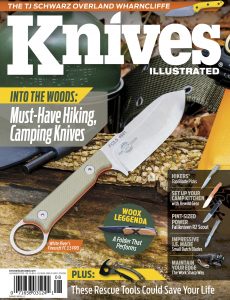
Knives Illustrated – July-August 2022
English | 84 pages | pdf | 26.11 MB
Hiking, camping, and general woods wandering are never far from my mind. It was front and center a few months ago when my daughter was assembling her backpacking gear. She was planning to tackle as much of the Appalachian Trail as she could before the next stage in her career would force her to cut the hike short.
As with most long-haul backpackers, she was obsessed with taking nothing but the lightest equipment. She carefully compared and weighed every piece of gear until she had what she believed was her minimal loadout.
“What are you bringing for a knife?” I asked.
Yes, she knew that I’ve been guilty of overpacking for outings. But I also had some experience with minimalist camping, carrying only what I could fit on an army surplus belt and in a canvas shoulder sack. I thought I had a valid question.
Her response was a much-practiced rolling of her eyes to indicate she didn’t need my advice. I’ll spare you the details of the ensuing father-daughter debate. In this contest I was most certainly the underdog, and no, I wasn’t able to pull off the upset over this very formidable opponent.
To summarize, she pointed out that while hiking the AT, she would be walking most of the day. Breakfast and lunch would consist of high-energy snack bars. The only cooking she’d be doing would be to boil 2 cups of water each night to pour into a pouch of freeze-dried food for her dinner. Each evening’s camp would entail either setting up her tent or staying in one of the many shelters along the trail. Every five days or so, she would stay in a hostel. She’d resupply in town or from packages we’d mail to her. She wouldn’t need much in the way of a knife.
It was my contention that she should bring enough knife as a safeguard against unexpected misfortune. My recommendation, considering both utility and weight as factors, was a Victorinox Hiker Swiss Army Knife. If she suffered a bad leg injury, she could use the saw blade to fashion crutches that would help more than her trekking poles. If her canister stove malfunctioned, she could use the can opener to make an alcohol stove out of a tuna can.
If she found herself stuck in an early spring snowstorm in the mountains, she could use the knife’s tools to provide tinder and kindling for a potentially lifesaving fire. If she broke or lost a tent stake, she could make a replacement. The awl could be used to repair her pack or other gear. If nothing else, she could salvage some of her cordage when her bear bag line gets caught in a tree branch. As a compromise, she did take a knife, but not any that I recommended.
This issue’s special section on hiking and camping focuses on lightweight carry blades— no big choppers in this one. While I normally have an axe, hatchet, saw, and large knife when camping near my vehicle, by far the knife I use most often is the one on my belt or in my pocket that’s readily available. So, here’s a salute to those small and mid-sized models that see lots of use at tasks both anticipated and unexpected for times when we need enough knife.
Steven Paul Barlow
Editor
Download from:
One Response to “Knives Illustrated – July-August 2022”